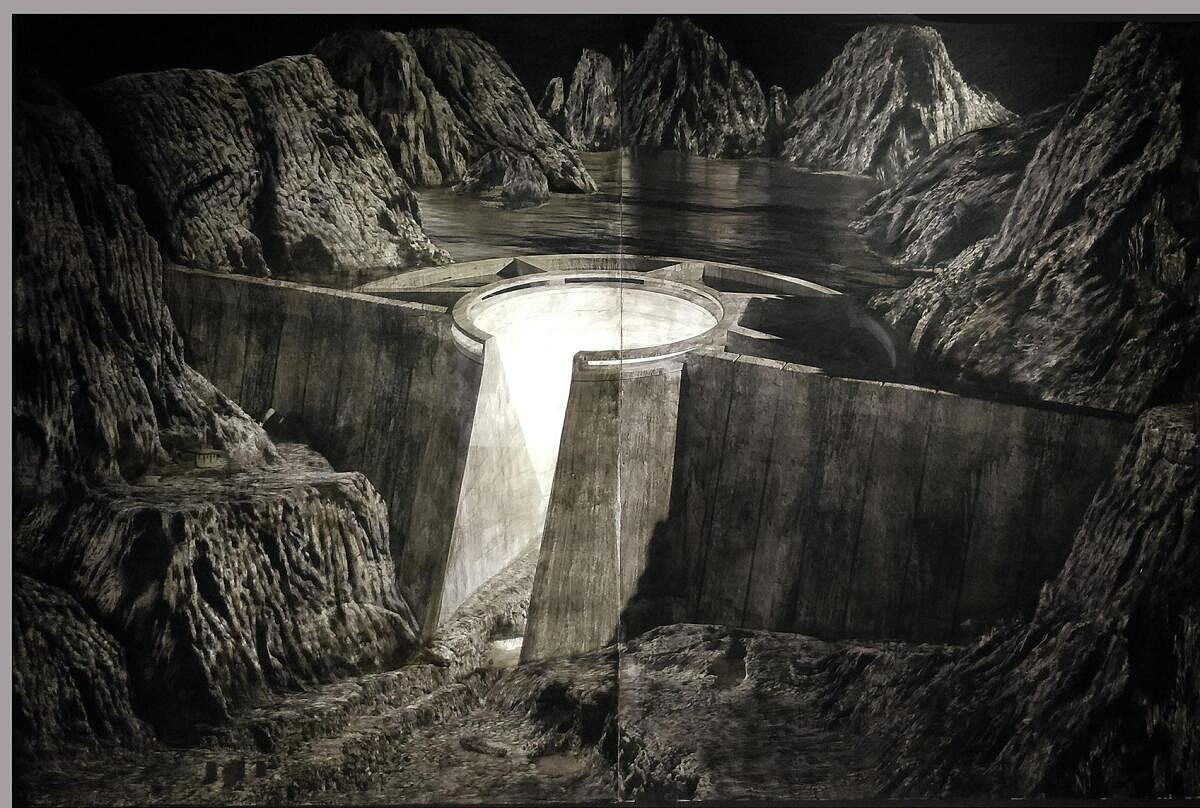Deep echoes in dark rooms


The fifth edition of Kochi-Muziris Biennale 2022 (KMB) had anything but a desirable opening. As many as 53 of the 90-odd participating artists penned an open letter expressing their dismay about unresponsive management and poor infrastructure, which had resulted in an eleven-day postponement from the designated date. Thankfully things have quite dramatically improved since then.
Curated by Singapore-based artist Shubigi Rao titled ‘In Our Viens Flow Ink And Fire’, the biennale is not only up and running but also attracting substantial crowds and critical attention from all quarters. It had received, according to the organisers, more than five lakh visitors by February 22, 2023.
A wide variety of artworks in over 200 projects spread across multiple venues of Fort Kochi, Mattancherry and Ernakulam are on display. There seems to be a special emphasis on the moving image, and many stunning installations have been set in dark chambers. Among the many outstanding works, the following are not to be missed:
Pranay Dutta
Twenty-eight-year-old Pranay Dutta, the youngest artist in Kochi-Muziris Biennale, shows great maturity in his shady but spellbinding video installations. An intense cinematic narrative merges the real with the surreal; beauty with dread; and history with the apocalypse. Devoid of any human presence, the works linger around a living landscape that resembles a mysterious corner of a bleak dystopian universe. Employing a uniquely developed visual language, the artist gently props up troubling questions about human anxiety, psychological destruction, and the deteriorating environment. Dutta’s monochromatic and surreal photographs — separately displayed at KMB — too carry the chilling visions and tensions of horrid mindscapes.
William Kentridge
South African artist William Kentridge (born 1955) comes up trumps with a gripping film projection set in an abandoned Soviet museum. Oh, To Believe In A Better World visualises the Tenth Symphony of Dmitri Shostakovich (1906-1975), an artist who barely survived a sticky affiliation with the then-political establishment. (The Tenth Symphony was written after Stalin’s death in 1953). In Kentridge’s film, several Soviet figures from the 1920s (including Stalin, Lenin, Trotsky and even Shostakovich) are comically featured as collage-like human figures and puppets. It is a well-crafted full-size costume drama which employs elements of puppetry, paintings, music, stop-frame animation, collage, and tapestry to make a strong visual and political statement.
Ali Cherri
Lebanese-French artist Ali Cherri’s multi-channel video installation is an intense take on the history of the Merowe Dam, one of the largest hydroelectric dams in Africa, located on the Nile River in Northern Sudan. In the film, we see a seasonal brickmaker under the blazing sun strenuously performing the gruelling task of shaping mud into bricks. Curiously, every night, he is secretly involved in building a mud-and-scrap structure, which ultimately transforms into a mystical creature with a monstrous bodily presence. The film is a gentle yet scathing commentary on the devastation wrought by the creation of the dam. The narrator of the film utters three unforgettable words: “Mud has memory.” Cherri’s fabulously constructed mud sculptures — Seated Figure, Lion, and Standing Figure — are also on display in an adjoining room of the Biennale. Mud, as Cherri rightly asserts, is as old as humanity itself.
Cecilia Vicuña
Known to explore serious issues related to nature, ancestral knowledge, ecological destruction, and cultural memory is senior Chilean artist and poet Cecilia Vicuña (born in 1948). In her film, she focuses her gaze on the unravelled red thread of a quipu, an ancient system of knots used by Andean populations to record events and for storytelling. The viewer is connected to the fabric floating along the River Mapacha, a waterway threatened with pollution, degradation and privatisation as it flows from glacier to sea. Vicuna ingeniously designs her work so that performance and poetry become interconnected with the symbolism of water, red and thread. The 74-year-old indigenous artist — a mestizo (a person of mixed race) — fled Chile in the 1970s following the military coup against former president Salvador Allende, and settled in New York City in 1980.
Hilde Skancke Pedersen
Norwegian artist Hilde Skancke Pedersen’s work provides a forceful commentary on elements of nature, their fundamental importance to our souls, and their degradation in modern times. In her film Eana, a naked, female body mirrors the shapes of the landscape in the Sámi hinterland suggesting the similarities between an ageing body and the rugged mountains, thereby revealing the intimate and inseparable connection of indigenous people with the land. Sacred Mountain, on the other hand, made of second-hand and found T-shirts, is a fascinating tapestry.
Bhumi
One of the major attractions of the Biennale is the community art project ‘Bhumi’. It features a breathtaking four-part installation narrating the story of the people of four different communities who lived in the Sathya Yuga — the kings, the baul singers, the farmers and the gram panchayat. The project by the people of Balia village in Thakurgaon, Bangladesh was driven by visual artist Kamruzzaman Shadhin. During the pandemic, Bhumi succeeded in bringing together artists, local farmers, artisans and materials including bamboo, straw and jute from the communities in north-western Bangladesh. The resulting installations focusing on indigenous farming, human-land relationships, and the complex connection between humans and the environment are truly evocative, both visually and in spirit.
The Kochi-Muziris Biennale runs until 10 April 2023.